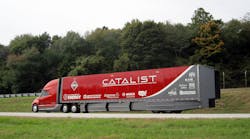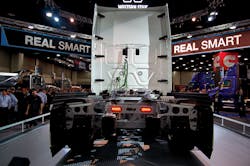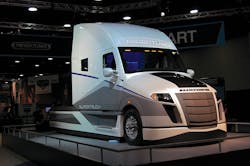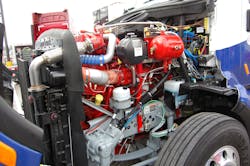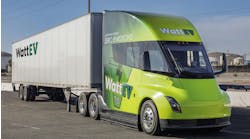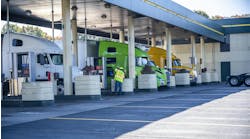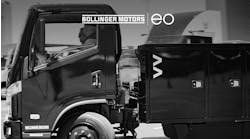In mid-2016, the U.S. Dept. of Energy (DOE) announced that it would fund a second heavy-truck research and development project, dubbed SuperTruck II, to the tune of $80 million. And many fleet managers might’ve rightly rolled their eyes, wondering whether such government expenditures ever result in real-world benefits for trucking companies.
Then you talk with someone like Wade Long, director of product marketing for Volvo Trucks North America (VTNA), who has been intimately involved with such research projects, and you get a whole new perspective on the potential fuel economy benefits of such programs.
During a panel discussion at the annual Technology & Maintenance Council (TMC) convention earlier this year, Long discussed some of the outcomes VTNA achieved from its participation in the SuperTruck I initiative. Launched in 2010, that program focused on efforts to improve tractor-trailer fuel, engine and drivetrain efficiency through the use of various “advanced technologies” such as improved aerodynamic designs, waste heat recovery systems, and the like.
Long noted that VTNA’s Super Truck project got an average of 12 mpg compared to 7 mpg gained by a 2009 model Volvo VNL tractor and standard trailer used as a “baseline” for comparative measurement. That difference of 5 mpg might not seem like much, but it translates into about $17,000 worth of fuel savings per truck per year, he emphasized.
That’s more than enough to offset the predicted direct costs of the Phase 2 greenhouse gas (GHG) rules, which are aimed at improved fuel economy for Class 8 tractors and trailers. The Environmental Protection Agency (EPA) estimates the costs will be as follows: upfront price increases of some $11,700 for tractors, $1,200 for trailers, $3,400 for vocational vehicles, and $1,300 for pickups/vans.
Now, not all the technologies and tweaks deployed for the SuperTrucks can be directly transitioned onto commercial vehicles operating in the real world. Yet in many ways, they are the “test beds” upon which OEMs determine whether fuel-saving improvements make the grade in terms of practicality, payback, reliability, etc.
For example, Long noted that VTNA started making changes to its 2016 models based on its SuperTruck work (that began in 2011), revising bumper fairings, chassis fairings, and roof fairing shapes.
Jeff Girbach, manager of engine technologies for Daimler Trucks North America (DTNA), also participated in the TMC panel discussion. He added that SuperTruck projects allow OEMs to pursue what he calls “high risk, high reward” technologies. He also noted that these projects often find that certain technologies can deliver more fuel savings in combination rather than individually, leading to what he calls “1+1+3” effects. “These projects are showing us that in terms of fuel efficiency, a truck can be more than the sum of its parts,” he explained.
Girbach noted that one of the biggest findings DTNA made from its SuperTruck work—one it’s applying to its new 2018 Freightliner Cascadia as well as other truck models—is that allowing a highway tractor to “coast” in neutral, letting the momentum of the vehicle maintain it at highway speed while allowing the engine fall to idle, can deliver bigger than anticipated fuel savings.
DTNA received $40 million—out of a total agency allotment of $115 million—from the DOE to develop its first SuperTruck combination vehicle seven years ago and will get $20 million as part of the SuperTruck II program.
DTNA’s SuperTruck I vehicle demonstrated a more than 50% improvement in overall freight efficiency and a 50% increase in engine brake thermal efficiency, or BTE, compared to a 2007 model-year tractor-trailer used as a baseline for the project.
The OEM’s prototype vehicle operated on two different on-highway routes in Oregon and Texas, recording a 52% and 61% increase in fuel improvement, respectively, in part because the SuperTruck tractor-trailer weighed in at 1,500 lbs. less than the baseline combination unit.
On top of that, many of the concepts used on DTNA’s SuperTruck platform, such as an integrated powertrain, 6x2 tractor axle optimization, and enhanced aerodynamics, became real-world components. New technologies such as a downsized engine coupled with a hybrid electric powertrain, along with a waste heat recovery system, provided a further fuel efficiency boost.
“At the end of the day, we’re trying to create the most efficient Class 8 chassis in the world,” Girbach explained.
Charles Chilton, Navistar’s director of product development, emphasized during TMC’s panel discussion that the “real trick” to transitioning the fuel efficiency improvements achieved by SuperTruck projects—ones like his company’s CatalIST combination vehicle—to “real-world” tractor models is to achieve “commercially viable” payback in a one- to two-year timeframe. The last three letters of the CatalIST stand for “International SuperTruck,” referencing the company’s International commercial track brand name.
The vehicle is connected to a Wabash-built trailer and achieves 13 mpg, improving “freight efficiency” by some 104% compared to the 2009 model tractor used as the baseline for the project. The vehicle also demonstrated a 50.3% BTE improvement, while establishing a “path,” in Chilton’s words, toward achieving a 55% improvement in BTE.
Navistar’s predictive cruise control technology is an example of a significant technical innovation the company achieved through the program.
Chilton said predictive cruise control looks ahead of the vehicle and recognizes the terrain and continuously calculates the most efficient speed and gear for optimal fuel economy in real time. Unlike conventional predictive cruise technology, the company’s predictive cruise control uses pre-installed GPS maps and the latest commercial route data to make adjustments to cruising speed without the need to pre-drive the route.
Other improvements fostered by the CatalIST included:
◗ A hybrid front suspension and lightweight rear suspension that leverages lightweight alloys with composite materials, reducing weight and enabling an electronic ride height management system, which provides dynamic ride height and pitch control for improved aerodynamics.
◗ Aerodynamic improvements that reduce the trailer’s drag coefficient by more than 30%.
Chilton added that the CatalIST truck can sustain 65 mph on the highway with just 80 engine horsepower. He also noted that the vehicle’s BTE improvements come from two distinct areas: two-thirds from the combined aerodynamics of the tractor-trailer and one-third from “system efficiencies” such as a reduction of parasitic loads on the engine.
Ken Damon, manager of vehicle performance for Peterbilt Motors Co., noted during his presentation at TMC that Peterbilt, engine maker Cummins and Eaton Corp. collaborated on a SuperTruck I project that also looped in TL carrier U.S. Xpress in order to keep “the voice of the customer” front and center during all of the research.
“We needed their input to decide what could become commercially viable and what could not,” he stressed.
In 2015 after Peterbilt initially completed its SuperTruck I project, Damon explained to Fleet Owner that the “test vehicles” represent “great examples of several things working together—optimizing components and systems, enhancing aerodynamic efficiencies, and maximizing operator performance.”
During testing, he said Peterbilt’s SuperTruck I vehicle—loaded out to 80,000 lbs.—achieved an average fuel economy of 10.4 mpg. And while Damon stressed that drivers will “always be essential to vehicle operation and fuel efficiency, automation does help immensely.”
Using technologies like predictive cruise control has a significant impact on fuel economy, as the vehicle optimizes acceleration, coasting and braking based on terrain, such as road inclines, far ahead of what the driver can anticipate, he explained.
The Cummins/Eaton/Peterbilt SuperTruck program combined a more efficient diesel engine, an advanced waste heat recovery system, an aerodynamic Peterbilt tractor and trailer combination, and a lithium ion battery-based auxiliary power unit to reduce overnight engine idling that in some cases helped the vehicle attain 10.7 mpg.
Yet attaining and sustaining such numbers in real-world work environments remains difficult, Damon said.
“Miles per gallon will always be duty-cycle dependent, and the transient nature of these duty cycles makes it difficult to state if certain fuel economy values will be able to be reached and maintained in specific environments,” he said.
Near term, Damon emphasized that the focus will be on convincing fleets to alter their truck and trailer specs to gain a more fuel-efficient footprint.
“Sometimes, out of habit or misconception, customers will still want to spec the largest engine with the most horsepower. That results in more weight and more fuel cost,” he explained. “After they realize they can get the job done just as well with a smaller-block engine, they never look back.”
Damon added that, like most truck OEMs, Peterbilt is continuing to develop “optimized spec packages” to not only deliver vehicles finely tuned for fuel efficiency to the best their application will allow but to simplify the ordering process for customers as well.
In 2014, the OEM introduced APEX, an optimized powertrain that pairs the Paccar MX-13 engine with Eaton’s Fuller Advantage AMT. The combination features optimized shift calibration, weight savings, and proprietary control logic that result in up to a 4% improvement in fuel efficiency.
Another new Peterbilt package that came out of the SuperTruck I effort is the Model 579 EPIQ, which can improve fuel efficiency by up to 14%, Damon said. The package combines APEX with a full range of aerodynamic add-ons and “closeouts” around the wheels, low rolling resistance tires, and other fuel-saving technologies.
Additionally, the ability to recover and store more energy via waste heat recovery systems that were tested in the SuperTruck are now being evaluated for real-world deployment.
“Adoption of waste heat recovery technology— the process of utilizing the excess heat generated from the engine as useful energy—will be a function of customer expectations, duty-cycle requirements, and payback,” he explained. “Yet it is a technology that has the potential to be key in delivering fuel efficiency gains in the future.”
Thus the whole point of such programs, Damon stressed, is to bring a “broad cascade of technology” to current products that was not previously possible yet keep them “economically viable” at the same time.
Vivek Sujan, director of product innovation at Cummins Inc., also sounded that “feasibility theme” during the panel discussion because the engine maker used its work on the SuperTruck I program to jump-start development of its new X15 line of heavy-duty engines.
“Looking at the [fuel economy] issue from the ground up in this program was a real eye-opener here,” he said. “It allowed us to perform a more ‘holistic’ analysis in terms of designing an engine to work within an entire system.”
That research also helped the company decide on a “differentiation’ strategy when it came to the new X15 engine family. For example, the 15-liter X15 Efficiency Series is “tuned” to provide maximum fuel economy, delivering 3% better fuel economy versus 2016 equivalent models and an over 10% improvement versus 2010 equivalent displacements.
By contrast, the 15-liter X15 Performance Series is focused on providing more power, especially for heavy loads. Those particular engines are rated between 485 and 605 hp. and deliver 1,650 to 2,050 lbs.-ft. of torque.
VTNA’s SuperTruck demonstrator, unveiled late last year, also worked to bring numerous prototype features into real-world operation on its current line of tractors—everything from top-of-cab solar panels powering the vehicle’s battery and interior lights, to its ultra-light aluminum frame and retooled 425 hp. 11-liter proprietary engine.
VTNA said its SuperTruck tractor-trailer combination boosted fuel efficiency by 70%—exceeding 12 mpg, with some test runs showing more than 13 mpg, noted Long—in road tests, with BTE reaching 50%.
In terms of differences when compared to current models, VTNA’s SuperTruck unit has a shorter front end than conventional trucks on the road today, with the hood featuring a sharper downward slope.
Lightweight fairings run the length of the tractor and trailer, and cameras have replaced rear view mirrors. The redesigned chassis is made almost entirely of aluminum, which cut the chassis weight in half, helping slice 3,200 lbs. out of the overall weight of the tractor-trailer.
Once again, automated technology plays a role in attaining fuel efficiency gains with an enhanced version of Volvo’s I-See, a new feature for the OEM’s proprietary I-Shift AMT. I-See memorizes thousands of routes and then uses that knowledge to optimize cruise speed and keep the AMT on board VTNA’s SuperTruck in the most fuel-efficient gear possible.
So, did any of those “advances” make it into Volvo’s “real-world” trucks? Three engine advancements developed through SuperTruck research did—the wave piston, turbo compounding system, and common rail fuel injection system. They are now integral parts of the OEM’s 2017 engine lineup.
Likewise, a number of VTNA SuperTruck-derived aerodynamic improvements are available for the company’s current VNL tractors. These include flared chassis fairings that improve air flow around the drive wheels, redesigned bumper, and turbulence-reducing deflectors.
And even small “tweaks” can deliver incremental fuel savings, which are magnified for a fleet based on the number of trucks it operates as well as by the mileage it accrues. As an example, VTNA’s Long noted that revisions made to the bumper on the 2016 model VNL derived from SuperTruck research helped deliver a 0.5% to 0.7% improvement in fuel economy.
“We also made changes to the chassis and roof fairing designs; subtle changes of less than an inch that help deliver better fuel economy,” he explained.
When all the tweaks are added up, Long said a 2016 model VNL ended up getting 3.5% better fuel economy compared to a 2015 model, and a good portion of those savings were derived from a 42% reduction in aerodynamic drag.
He added that the aforementioned 2017-model Volvo D11 and D13 engines, retooled with improvements gleaned from the OEM’s SuperTruck research, deliver between 2.2% to 6.5% better fuel efficiency compared to 2014-model units.
“This is only the start,” Long stressed. “We see a lot of opportunity to make more changes.”
